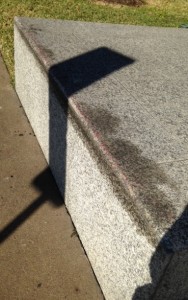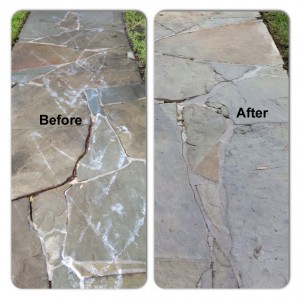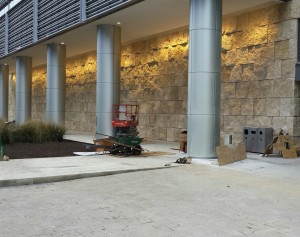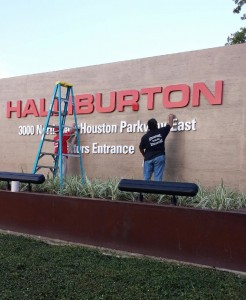Many buildings today are not just installing gorgeous stone lobby floors. They are also starting to renovate their outside floors, signs and walls. With the installation of exterior stone, comes the question of how much more maintenance will these surfaces require? Of course we ask how the stone will stand up against the elements such as rain and sun exposure, but we also have to ask if the stone can resist human activities, like skate boarding and vandalism.
If your need is water repellency, look no further than penetrating sealer, Seal & Go® S.
This sealer is not a coating; it goes into the pores of the stone and repels non-acid liquids like water and grease. For exterior surfaces, it is best to re-seal the stone annually.
Seal & Go® S also helps stone resist grease from skateboards and will prevent oils from penetrating deeply into the stone. The sealer won’t stop the grease from slicking on the surface, but it will help with the stain removal process.
If your exterior benches or planters already have skateboard grease stains, International Stoneworks can apply a poultice on the stain.
Per the Marble Institute of America Glossary, “poulticing” is,
“The use of a porous solid mixed with solvents or other liquids such as hydrogen peroxide or bleach used to remove deep stains from porous stones such as marble or granite. (DO NOT MIX BLEACH AND AMMONIA.)
Please note that poultices work on surface stains, but deep stains may not be completely removed.

Now, on to the issue of vandalism. If you are concerned that your building’s exterior walls may be susceptible to graffiti, I recommend an anti-graffiti coating, which prevents the paint from the graffiti from bonding to the stone surface. There are three types of coatings:
1. Sacrificial coatings: This clear coat barrier is applied to the surface of the stone. When the stone is vandalized by graffiti, the sacrificial coating can be removed with a high-pressure washer and a graffiti cleaner. A new coating can be re-applied after this cleaning. Sacrificial coatings are typically made of clear polymers that form a weak bond with the substrate and can be removed fairly easily.
2. Semi sacrificial coatings: This safety shield is a coating as well as a penetrating sealer. After a vandalism attack, the coating can be partially removed with a graffiti cleaner and a high-pressure washer.
3. Permanent coatings: This coating typically changes the look of the stone surface, giving it a shinier appearance. It is a protective layer that prevents the graffiti from touching the surface of the stone; however, it can be very difficult to strip off and may not be the best solution.

Ultimately, we need to determine which sealer/coating is right for your stone surface and substrate, and determine if the surface is susceptible to a graffiti attack.
Anti-graffiti coatings do not have to alter the natural look of the stone, but keep in mind, it may darken the color slightly.


